Lucknow, the enchanting capital of Uttar Pradesh, India, is a city steeped in history and culture. With a rich heritage that spans over centuries, Lucknow is a melting pot of traditions, architecture, and cuisine. Known as the "City of Nawabs," it once served as the seat of the opulent Nawabi dynasty.
The city's architectural splendor is evident in its magnificent monuments like the Bara Imambara, Chota Imambara, and Rumi Darwaza. These landmarks reflect the exquisite blend of Mughal and Awadhi styles, captivating visitors with their grandeur.
Lucknow's cultural tapestry shines through its language, music, and art. The elegant dance form of Kathak originated here, exemplifying the city's artistic legacy. Moreover, the courteous demeanor of its people and their culinary expertise, renowned for delectable kebabs and biryanis, add to the city's allure.
In modern times, Lucknow continues to thrive as a major cultural, educational, and commercial hub, blending its glorious past with a promising future.
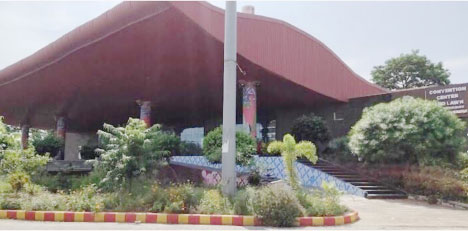
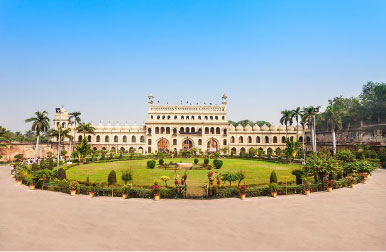
Counted among the top historical places in Lucknow, Bara Imambara aka Asafi Imambara is a historical monument that dates back to 1784. Built by Asaf-ud-Daula, one of the renowned Nawabs of Awadh, the complex comprises a large mosque (Asfi Mosque), a labyrinth (the Bhul Bhulaiya), and a stepwell with running water (Shahi Baoli). The structure boasts of two large gateways that will lead you to the central hall, which is touted to be the largest vaulted chamber in the world.
The imposing historical structure of Chota Imambara was built in 1838 by Muhammad Ali Shah, the third Nawab of Awadh. Also called Imambara Hussainabad Mubarak, it was initially built as a congregation hall for the devotees of the Shia community. However, the place later served as the mausoleum for the Nawab as well as his mother. The interiors of the structure are beautifully ornamented with chandeliers and crystal lamps brought from Belgium which earned it the moniker ‘the Palace of Lights’. The exteriors feature elements of intricate Islamic calligraphy, adding to its visual appeal.
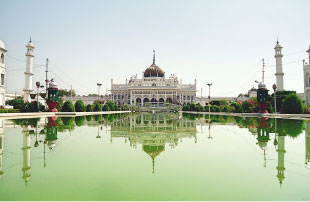
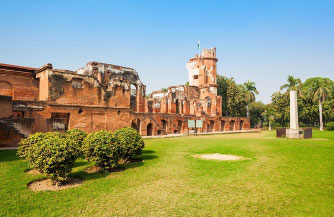
Also called the Residency and the Residency Complex, the British Residency is a complex of buildings that once served as the residence of the British Resident General. Constructed in the last quarter of the 18th century, the place served home to over 3000 British residents during the Indian Rebellion of 1857. Currently, the Residency is in ruins and is a protected monument under the Archeological survey of India.
When you want to witness the grandeur of the Awadhi style of architecture, make your way to the Rumi Darwaza, an imposing gateway located between Bara Imambara and Chota Imambara. This gateway built in 1784 by Nawab Asaf-ud-Daula is about 60-feet tall and is generally used as the logo for Lucknow city. Since the gate is modeled after the Sublime Porte in Istanbul, it is sometimes referred to as the Turkish Gate.
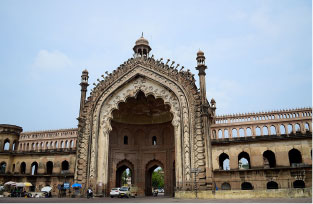
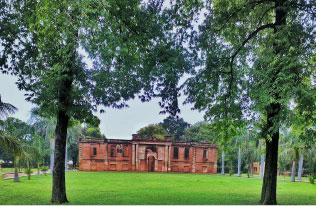
Located on the banks of the River Gomti, Dilkusha Kothi is the remains of a house that was built in the early 19th century. Built in the English baroque style of architecture, the building once served as the hunting lodge and summer resort of the Nawabs. Nothing much is left of the building today, except for the external walls, a few towers, and a beautiful garden. However, due to its historical significance and architectural grandeur, Dilkusha Kothi has earned a place in the list of Lucknow tourist places.
Located adjacent to the Rumi Darwaza, Husainabad Clock Tower is another heritage monument dotting the cityscape of Lucknow. Built in 1881 by the Hussainabad Trust at a cost of 1.75 lakhs, this 221-feet structure is modeled after the Big Ben Clock Tower of London. The clock is designed like a flower with 12 petals and its pendulum is 14 feet long. Popular as the tallest clock tower in the country, it displays the Gothic and Victorian styles of architecture.
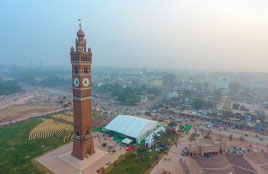
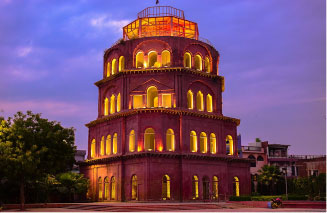
An iconic watchtower located in Lucknow, Satkhanda is an incomplete, four-storied structure that dates back to the 1800s. King Mohammed Ali Shah who started the construction of the building planned it to be a watchtower with seven stories but could complete only four due to his untimely demise. The design of this red-brick tower shows influences of the Leaning Tower of Pisa, which makes it one of the interesting monuments to visit in Lucknow.